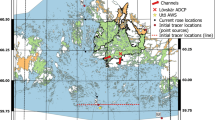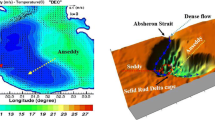Abstract
The deflection of oceanic or tidal currents into pockmarks has been studied by both general three-dimensional computational fluid dynamics simulations and acoustic measurements in a number of pockmarks in the Inner Oslofjord, Norway. The modeling demonstrates upstream convergence of flow lines, followed by upwelling over the pockmark. This upwelling is an effect of deflected regional currents, not of expulsion of fluids or gas from the seafloor, and is sufficiently strong to prevent the settling of fine particles. The field measurements, although noisy at low vertical velocities, are consistent with the hypothesis of upwelling. The reduction in sedimentation rate inferred over the pockmarks (relative to that of the flat surrounding seabed) can explain the maintenance, or even deepening of pockmarks in the absence of fluid or gas seepage. The current pattern may also have consequences for the marine biology of pockmarks.
Similar content being viewed by others
References
Bøe R, Rise L, Ottesen D (1998) Elongate depressions on the southern slope of the Norwegian Trench (Skagerrak): morphology and evolution. Mar Geol 146:191–203
Dando PR, Austen MC, Burke RJ, Kendall MA, Kennicutt MC, Judd AG, Moore DC, O’Hara SCM, Schmaljohann R, Southward AJ (1991) Ecology of a North Sea pockmark with an active methane seep. Mar Ecol Prog Ser 70:49–63
Genin A (2004) Bio-physical coupling in the formation of zooplankton and fish aggregations over abrupt topographies. J Mar Syst 50:3–20
Gray JS (1974) Animal-sediment relationships. Oceanogr Mar Biol Annu Rev 12:223–261
Hammer Ø, Harper DAT, Ryan PD (2001) PAST: paleontological statistics software package for education and data analysis. Palaeontol Electronica 4(1)
Harrington PK (1985) Formation of pockmarks by pore-water escape. Geo-Mar Lett 5:193–197. doi:10.1007/BF02281638
Hovland M (1983) Elongate depressions associated with pockmarks in the western slope of the Norwegian Trench. Mar Geol 51:35–46
Hovland M (2005) Pockmark-associated coral reefs at the Kristin field off Mid-Norway. In: Freiwald A, Roberts JM (eds) Cold-water corals and ecosystems. Springer, Berlin Heidelberg New York, pp 623–632
Hovland M, Judd AG (1988) Seabed pockmarks and seepages. Graham & Trotman, London
Hovland M, Gardner JV, Judd AG (2002) The significance of pockmarks to understanding fluid flow processes and geohazards. Geofluids 2:127–136
Josenhans HW, King LH, Fader GB (1978) A side-scan sonar mosaic of pockmarks on the Scotian Shelf. Can J Earth Sci 15:831–840
Khandriche A, Werner F (1995) Freshwater induced pockmarks in Bay of Eckernfoerde, Western Baltic. In: Mojski JE (ed) Proc 3rd Marine Geological Conf The Baltic. Panstwowy Instytut Geologiczny, Warzawa, pp 155–164
Kranck K (1975) Sediment deposition from flocculated suspensions. Sedimentology 22:111–123
Lamb H (1994) Hydrodynamics, 6th edn. Cambridge University Press, Cambridge
Manley PL, Manley TO, Watzin MC, Gutierrez J (2004) Lakebed pockmarks in Burlington Bay, Lake Champlain: I. Hydrodynamics and implications of origin. In: Manley TO, Manley PL, Mihuc TB (eds) Lake Champlain: Partnerships and research in the new millennium. Springer, Berlin Heidelberg New York, pp 299–330
Marinaro G, Etiope G, Bue NL, Favali P, Papatheodorou G, Christodoulou D, Furlan F, Gasparoni F, Ferentinos G, Masson M, Rolin J-F (2006) Monitoring of a methane-seeping pockmark by cabled benthic observatory (Patras Gulf, Greece). Geo-Mar Lett 26:297–302. doi:10.1007/s00367-006-0040-4
Rosenberg R (1995) Benthic marine fauna structured by hydrodynamic processes and food availability. Neth J Sea Res 34:303–317
Scanlon KM, Knebel HJ (1989) Pockmarks in the floor of Penobscot Bay, Maine. Geo-Mar Lett 9:53–58. doi:10.1007/BF02262818
Ussler W, Paull CK, Boucher J, Friederich GE, Thomas DJ (2003) Submarine pockmarks: a case study from Belfast Bay, Maine. Mar Geol 202:175–192
Webb KE, Hammer Ø, Lepland A, Gray JS (2009) Pockmarks in the Inner Oslofjord, Norway. Geo-Mar Lett 29:111–124. doi:10.1007/s00367-008-0127-1
Wildish DJ, Akagi HM, McKeown DL, Pohle GW (2008) Pockmarks influence benthic communities in Passamaquoddy Bay, Bay of Fundy, Canada. Mar Ecol Prog Ser 357:51–66
Author information
Authors and Affiliations
Corresponding author
Rights and permissions
About this article
Cite this article
Hammer, Ø., Webb, K.E. & Depreiter, D. Numerical simulation of upwelling currents in pockmarks, and data from the Inner Oslofjord, Norway. Geo-Mar Lett 29, 269–275 (2009). https://doi.org/10.1007/s00367-009-0140-z
Received:
Accepted:
Published:
Issue Date:
DOI: https://doi.org/10.1007/s00367-009-0140-z




